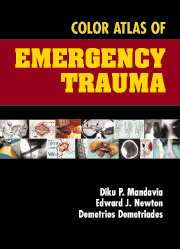7 - SPINAL INJURY
Published online by Cambridge University Press: 10 November 2010
Summary
Introduction
One of the most devastating consequences of trauma is spinal cord injury. In the United States, approximately 10,000 spinal cord injuries yearly result in permanent disability. Although spinal fractures can occur in any age group, the peak incidence is in males from ages 18 to 25. Certain conditions predispose to spinal fracture or dislocation: old age, rheumatoid arthritis, osteoporosis, Down's syndrome, and spinal stenosis. Even relatively minor mechanisms can result in spinal fracture in these groups. Forces that injure the spinal column include flexion, extension, axial loading, shear force, and rotational acceleration.
Clinical Examination
All multiple trauma victims must undergo evaluation for possible spinal column fracture, dislocation, or spinal cord injury. Blunt trauma patients should have the spine immobilized at first medical contact and remain in spinal immobilization until the integrity of the cord and spinal column can be verified. In patients with multiple severe injuries, this verification can be deferred until more critical injuries have been addressed, provided that immobilization of the spine is maintained.
Patients with spinal fractures experience pain, and examination will reveal tenderness. However, patients who are unable to report pain because of concomitant head injury or intoxication may harbor occult spinal injuries and should remain immobilized until they can be accurately evaluated. Patients with spinal cord injury manifest symptoms according to the spinal cord level affected. With complete cord transection, all motor and sensory function below the level of the lesion is lost. The highest intact sensory level should be marked on the patient to determine whether the cord lesion is progressing proximally on subsequent examinations.
- Type
- Chapter
- Information
- Color Atlas of Emergency Trauma , pp. 219 - 258Publisher: Cambridge University PressPrint publication year: 2003



